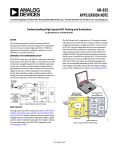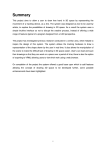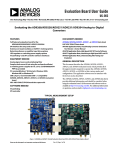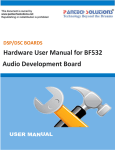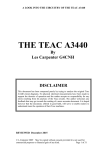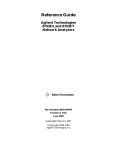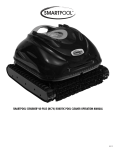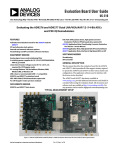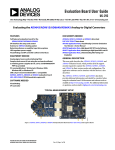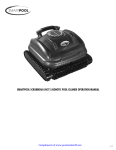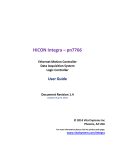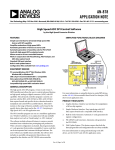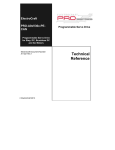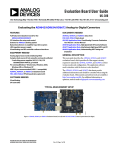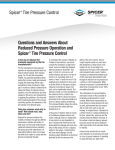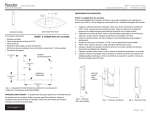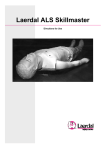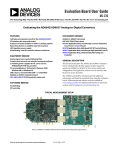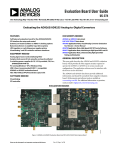Download AN-835 (Rev. A)
Transcript
AN-835 APPLICATION NOTE One Technology Way • P.O. Box 9106 • Norwood, MA 02062-9106, U.S.A. • Tel: 781.329.4700 • Fax: 781.461.3113 • www.analog.com Understanding High Speed ADC Testing and Evaluation by Alex Arrants, Brad Brannon and Rob Reeder SCOPE DYNAMIC TEST HARDWARE SETUP This document describes both the characterization and production test methods used by the High Speed Converter Group of Analog Devices, Inc., to evaluate high speed analog-to-digital converters (ADCs). While this application note should be considered a reference, it is not a substitute for a product data sheet. SNR, SINAD, worst spur, and IMD are tested using a hardware setup similar to that shown in Figure 1. In production tests, the test hardware is highly integrated, but the hardware principles are the same. The basic setup for dynamic testing includes a signal generator, band-pass filter, test fixture, low noise power supplies, encode source (often integrated on the evaluation board), data acquisition module, and data analysis software. Analog Devices provides application hardware and software to aid in bench evaluation. WALL OUTLET 100V TO 240V AC 47Hz TO 63Hz SWITCHING POWER SUPPLY SWITCHING POWER SUPPLY 6V DC 2A MAX SIGNAL SYNTHESIZER 6V DC 2A MAX 4LO INPUT ANALOG INPUT SIGNAL SYNTHESIZER PC RUNNING ADC ANALYZER OR VISUAL ANALOG USER SOFTWARE AGILENT POWER SUPPLY OPTIONAL CLOCK INPUT SPECTRUM ANALYZER OSCILLOSCOPE OR SIGNAL SYNTHESIZER 05941-001 GAIN CONTROL INPUT CW I/Q OUTPUTS Figure 1. Typical Characterization Test Setup Rev. A | Page 1 of 28 AN-835 Application Note TABLE OF CONTENTS Scope .................................................................................................. 1 Dither Testing ............................................................................. 16 Dynamic Test Hardware Setup ....................................................... 1 Analog Input ............................................................................... 17 Revision History ............................................................................... 3 Analog Input Impedance ...................................................... 17 HSC-ADC-EVALC Evaluation Platform .................................. 4 Voltage Standing Wave Ratio (VSWR)................................ 17 Background ....................................................................................... 5 Analog Input Full-Scale Range (V p-p) .................................. 18 ADIsimADC ................................................................................. 5 Common-Mode Input Range (V) ............................................ 19 Analog Signal Source ................................................................... 6 Common-Mode Rejection Ratio (CMRR, dB) ...................... 19 Analog Signal Filter ...................................................................... 6 Aperture Delay (AD, ps)............................................................ 20 Encode Signal Sources ................................................................. 7 Aperture Jitter or Aperture Uncertainty (ps RMS) ................ 21 Power Supplies .............................................................................. 8 Crosstalk (dB) ............................................................................. 21 Data Acquisition ........................................................................... 8 Condition One ........................................................................ 21 AC Test Definitions .......................................................................... 9 Condition Two........................................................................ 21 FFT Testing.................................................................................... 9 Input-Referred Noise (LSB RMS) ............................................ 21 Single-Tone FFT ........................................................................... 9 Out-of-Range Recovery Time (CLK Cycles) ............................. 21 Signal-to-Noise Ratio (SNR, dB)............................................ 9 Digital Time Domain ................................................................. 21 Signal-to-Noise Ratio Referenced to Full Scale (SNRFS, dBFS) .......................................................................................... 9 Minimum Conversion Rate (MSPS).................................... 21 Signal-to-Noise-and-Distortion (SINAD, dB) ..................... 9 Pipeline Delay (CLK Cycles) ................................................ 22 User-Defined Signal-to-Noise Ratio (UDSNR, dB) ............ 9 Propagation Delay (ns) .......................................................... 23 Noise Figure (NF, dB) .............................................................. 9 Encode Pulse Width or Encode Duty Cycle ....................... 23 Noise Floor (dBFS)................................................................. 10 Conversion Error Rate (CER)................................................... 24 Effective Number of Bits (ENOB, Bits) ............................... 10 DC Test Definitions ....................................................................... 25 Spurious-Free Dynamic Range (SFDR, dBc) ..................... 10 Gain Error (%FS)........................................................................ 25 Harmonic Distortion (dBc or dBFS) ................................... 10 Gain Matching (%FS) ................................................................ 25 Total Harmonic Distortion (THD, dBc) ............................. 10 Offset Error (%FS) ..................................................................... 25 Harmonic Image (dBc) .......................................................... 10 Offset Matching (mV) ............................................................... 25 Two-Tone FFT ............................................................................ 12 Temperature Drift (ppm) .......................................................... 25 F1 + F2 (dBc) .......................................................................... 12 Voltage Output High/Voltage Output Low (VOH/VOL, V) ..... 25 F2 − F1 (dBc) .......................................................................... 12 Linearity....................................................................................... 25 Second-Order Input Intercept Point (IIP2, dBm).............. 12 Differential Nonlinearity Error (DNL, LSB) ...................... 26 2F1 ± F2 and 2F2 ± F1 (dBc) ................................................ 12 Missing Code .......................................................................... 26 Third-Order Input Intercept Point (IIP3, dBm) ................ 12 Integral Nonlinearity Error (INL, LSB)............................... 26 Worst Other Spur (WoSpur, dBc) ........................................ 12 Power Supply Rejection Ratio (PSRR, dB) ............................. 27 Two-Tone SFDR (dBc) .......................................................... 12 References ........................................................................................ 28 Noise Power Ratio (NPR, dB) ................................................... 14 Additional References ................................................................ 28 Maximum Conversion Rate (MSPS) ................................... 21 Full Power Bandwidth (MHz) .................................................. 15 Rev. A | Page 2 of 28 Application Note AN-835 REVISION HISTORY 6/10—Rev. 0 to Rev. A Added Alex Arrants to by ................................................................ 1 Changes to Dynamic Test Hardware Setup Section and Figure 1 ............................................................................................... 1 Changes to HSC-ADC-EVALC Evaluation Platform Section and Figure 2........................................................................................ 4 Changes to Figure 3, ADIsimADC Section, and Figure 4 ........... 5 Changes to Analog Signal Source Section, Analog Signal Filter Section, Figure 5, and Figure 6 ........................................................ 6 Changes to Encode Signal Sources Section ................................... 7 Changes to Figure 10, Power Supplies Section, Figure 11, and Data Acquisition Section .................................................................. 8 Added Figure 12; Renumbered Sequentially ................................. 8 Changes to User-Defined Signal-to-Noise Ratio (UDSNR, dB) Section and Noise Figure (NF, dB) Section ................................... 9 Changes to Noise Floor (dBFS) Section and Effective Number of Bits (ENOB, Bits) Section .......................................................... 10 Changes to Figure 13 ...................................................................... 11 Changes to Figure 14 ...................................................................... 13 Changes to Figure 17 ...................................................................... 14 Changes to Figure 19 ...................................................................... 15 Changes to Dither Testing and Figure 20 .................................... 16 Changes to Figure 21 ...................................................................... 17 Changes to Figure 22 ...................................................................... 18 Changes to Common-Mode Input Range (V) Section, CommonMode Rejection Ratio (CMRR, dB) Section, and Figure 23 .......... 19 Changes to Aperture Delay (AD, ps) Section and Figure 24 ..... 20 Changes to Input-Referred Noise (LSB RMS) Section............... 21 Added Figure 26 .............................................................................. 21 Changes to Pipeline Delay (CLK Cycles) Section ....................... 22 Added Figure 27 .............................................................................. 22 Changes to Figure 28 ...................................................................... 23 Changes to Conversion Error Rate (CES) Section and Table 1 ............................................................................................... 24 Added Figure 29 .............................................................................. 24 Changes to References Section ...................................................... 28 4/06—Revision 0: Initial Version Rev. A | Page 3 of 28 AN-835 Application Note HSC-ADC-EVALC EVALUATION PLATFORM The FPGA-based buffer memory board can be connected to a PC through a standard USB cable and used with the VisualAnalog and SPIController software to quickly evaluate the performance of the high speed ADCs. Users can change settings in the SPI registers unique to the individual ADC product, view an FFT for a specific analog input and sample rate, and analyze SNR, SINAD, SFDR, and harmonic information, as well as time domain information, such as gain and offset. The HSC-ADC-EVALC supports CMOS, LVDS, and CML outputs. Some boards may require an interposer or slightly different FIFO alternative. If additional or different hardware is necessary, it will be specified in the product data sheet. For more detailed information on the HSC-ADC-EVALC, the SPIController, and how the VisualAnalog software works, visit www.analog.com/FIFO. The high speed ADC FIFO evaluation kit (HSC_ADC_EVALC) includes a FPGA-based buffer memory board to capture blocks of digital data from Analog Devices high speed ADC evaluation boards, VisualAnalog®, and SPIController software. For more information on the HSC-ADC-EVALC evaluation platform, visit www.analog.com/FIFO. ON-BOARD VOLTAGE REGULATORS HSC-ADC-EVALC SINGLE OR MULTICHANNEL HIGH SPEED ADC EVALUATION BOARD n J3* LOGIC FILTERED ANALOG INPUT ADC FPGA CONFIGURATION MODE LED2 J2* FIFO CONTROL(9) CLKA(2) DATA BUS 1(18) EXT SYNC2 J1* UPLOAD FPGA DONE J6 USB CONTROLLER USB CONFIG PROM FPGA CONFIG PROM FPGA GPIO(8) SPI(7) USB DIRECT(5) CAPTURE PORTB PORTD PORTC PORTE PORTA CLKB(2) EXT SYNC1 CLOCK CIRCUIT LED1 DATA(16) DATA BUS 2(18) FPGA n SPI USB USB CONNECTOR STANDARD USB 2.0 ONBOARD VOLTAGE J4 REGULATORS POWER CONNECTOR RECONFIG J10 *DATA CONVERTER I/O CONNECTORS JTAG CONNECTOR CLOCK INPUT Figure 2. Typical HSC-ADC-EVALC Evaluation Platform Rev. A | Page 4 of 28 05941-002 POWER CONNECTOR Application Note AN-835 BACKGROUND GENERAL PURPOSE I/O, USB/SPI CONTROL DATA BUS 1 DATA BUS 2 FPGA LOAD SELECT XILINX VIRTEX-4 FPGA DEBUG PINS ON BOARD POWER SUPPLY 100MHz OSCILLATOR EXTERNAL SYNC I/O FPGA I/O VOLTAGE MODE CYPRESS USB CONTROLLER USB CONNECTOR FPGA JTAG CONNECTOR 5VDC POWER INPUT 05941-003 FPGA CONFIG PROM Figure 3. HSC-ADC-EVALC: FPGA-Based Data Capture Board ADIsimADC™ is Analog Devices ADC behavioral modeling tool. ADIsimADC accurately models many of the time and frequency domain errors common to ADCs. This tool can be invaluable in terms of both simple converter selection and complete system simulation. Although the tool is fully integrated into the VisualAnalog software to aid in simple converter selection; it is also supported by several third-party CAD vendors. Currently, ADIsimADC is supported by MATLAB®, C++, National Instruments LabVIEW™ SignalExpress, Agilent’s ADS, and Applied Wave Research’s Visual System Stimulatior™. Others will be available in the future. The tool can be downloaded from the website along with a complete collection of current models. Links are provided to third-party tools that support ADIsimADC. For more information on ADIsimADC behavioral modeling, visit www.analog.com/ADIsimADC. For more detailed information on ADIsimADC, see the AN-737 Application Note at www.analog.com. 05941-004 ADIsimADC Figure 4. VisualAnalog: Typical Canvas Showing an FFT and Time Domain Performance Plots Rev. A | Page 5 of 28 AN-835 Application Note 0 ANALOG SIGNAL SOURCE IL 0.3dB @ 10MHz –10 ATTENUATION (dB) –20 –30 –40 –50 –60 40 ANALOG SIGNAL FILTER 60 80 100 120 FREQUENCY (MHz) There are two types of filters that are often used for ADC testing: low-pass filters and band-pass filters. These can be used individually or combined to yield the level of performance required for an application. Figure 5. Typical Performance of TTE’s J97 0 –10 ATTENUATION (dB) Both fixed frequency and tunable frequency band-pass filters are used for device testing. The fixed frequency filters are typically smaller than tunable filters and often provide slightly better performance. Tunable filters allow testing across a wide range of frequencies using one filter. Several filter manufacturers, including K&L Microwave, TTE, and Allen Avionics, Inc., provide excellent filters for ADC testing. 05941-005 Usually, dynamic testing employs a Rohde & Schwarz SMA/ SMHU/SMG/SMGU, an Agilent 8644 signal generator, a Wenzel crystal oscillators or a Valpey Fisher crystal oscillator. These sources have proven to provide exceptional performance (low phase noise, flat frequency response, and reasonable harmonic performance) for frequencies of a few kilohertz to those of a few gigahertz. Harmonic performance of these generators is typically not as good as the intrinsic linearity of a given ADC, mandating the need for additional filtering between the signal generator and the analog input to the ADC. IL 3dB @ 100MHz –20 –30 –40 Band-pass filters are used when analog frequencies are fixed and will not be changed. Band-pass filters also eliminate much of the wideband noise generated by signal sources and typically provide the best performance for ADC testing. Filters such as TTE’s Q70T series have a bandwidth defined as a percentage of the center frequency. The more narrow the bandwidth, the less noise that passes through the filter; however, the analog frequency is more restricted, and there is a greater insertion loss. When a center frequency is chosen, the bandwidth can be determined. Ideally, a bandwidth of 5% to 6% should be selected, keeping in mind that good noise performance is being traded for analog frequency flexibility. As with low-pass filters, the band-pass filter has a transition band that defines the shape between the 3 dB frequency (above and below the center frequency) and the frequency of the guaranteed stop-band performance. In the case of TTE’s Q70T, the stop-band rejection is 60 dB. –60 85 90 95 100 105 110 FREQUENCY (MHz) 115 08941-006 –50 Low-pass filters are a good choice when a wide range of analog frequencies must be applied to the ADC. However, they allow noise to pass from the signal generator to the ADC. This noise may reduce the level of performance measured for the ADC. A typical low-pass filter is the J97 available from TTE. Usually, lowpass filters have a transition band that defines where the pass band ends and the stop band begins. Along with this specification, a guaranteed stop-band rejection is specified. In the case of the J97, the transition band is defined to be between 1.0 times and 1.2 times the 3 dB frequency, and the guaranteed stop-band rejection is 80 dB. Energy beyond 1.2 times the 3 dB frequency is reduced by a minimum of 80 dB. Figure 6. Typical Band-Pass Performance of TTE’s Q70T As noted previously, band-pass filters may only have a stop-band rejection of 60 dB, meaning that signals that fall into the stop band will be rejected by 60 dB. If, for example, a signal source has a harmonic that is 25 dB below the fundamental, the effective level of the harmonic is −85 dBc after a Q70T filter. For many high performance ADCs, this is not sufficient. When performance of −100 dBc or better is required, it is common to cascade a band-pass filter with a low-pass filter. When selecting a low-pass filter to follow a band-pass filter, the low-pass frequency should be selected such that stop-band performance of the low-pass filter optimally filters any harmonics that pass through the band-pass filter. With a J97 low-pass filter, stop-band rejection is reached at 1.2 times the 3 dB frequency. If the second harmonic of the bandpass filter is set equal to 1.4 times the low-pass 3 dB frequency, it ensures that all harmonics passing through the band-pass filter are filtered and that the additional insertion loss of the low-pass filter does not significantly reduce the level of the desired pass band. In this case, the low-pass frequency should equal 1.4 times the bandpass frequency, and theoretically, the cascaded rejection should be about 140 dB. Although this is difficult to achieve in practice due to coupling and radiation effects, this technique is a useful one and can achieve well beyond −100 dBc harmonic rejection. Rev. A | Page 6 of 28 Application Note AN-835 It is also worth noting that a 0.5 dB to 3 dB attenuator can be placed between the band-pass and low-pass series combination. This helps to provide a better match between the two filters, which are nominally specified at 50 Ω. When specifying filters, request those made with large cores to prevent saturation. Filters are typically designed for an input power of about +15 dBm. In many cases, however, ADC drive requirements are much larger than this, causing core saturation and distortion. Specifying larger cores reduces the spurious distortion caused by core saturation. Finally, it is worth mentioning that filter connectors can also be specified. Although adapters are easily found to convert between connector types, using them introduces mismatches that can subtly affect converter performance. While this may not be a problem with 8-bit and 10-bit converters, it is quite noticeable with 12-, 14-, and 16-bit converters. It is very important that an appropriate clock oscillator be used in each ADC design. Selection of the proper clock is aided by Analog Devices AN-501 Application Note, AN-756 Application Note, and Analog-to-Digital Converter Clock Optimization: A Test Engineering Perspective and can be found at www.analog.com. These application notes explain how to measure aperture jitter and how to specify a clock that meets the required phase noise or jitter specification. Failure to properly specify a clock source will degrade SNR performance, as shown in Figure 8 and Figure 9. As a reference, a typical Wenzel clock oscillator has about 0.07 ps of aperture jitter, whereas the CMOS clock oscillators have about 0.3 ps or more of aperture jitter. ENCODE SIGNAL SOURCES 05941-008 For high performance converters, stock signal generators usually are insufficient as encode sources because of both close-in and wideband phase noise. Fixed-frequency oscillators are typically used for encode sources. High performance crystal oscillators manufactured by Wenzel and Techtrol Cyclonetics, Inc., (TCI) can be used. Wenzel’s Sprinter and Ultra Low Noise series can offer optimum phase noise performance. Another source of high quality encode sources is Valpey Fisher, which offers several options, including differential PECLs and voltage-controlled crystal oscillators (VCXOs). For less demanding applications, standard CMOS clock modules can be used and are available from various manufacturers. For end applications that require the clock to be synchronized with an external reference, a VCXO in a PLL loop can be employed as found in products like the AD9516. 05941-009 Figure 8. AD9445 with Analog IF of 130 MHz @ −1.0 dBFS using a Wenzel Clock, SNR = 75.2 dBFS 05941-007 Figure 9. AD9445 with Analog IF of 130 MHz @ −1.0 dBFS using a CMOS Clock, SNR = 71.2 dBFS Figure 7. Typical Low Cost CMOS Clock Oscillator When clock sources are not available with the desired jitter performance, it is possible to divide a higher frequency clock into lower rates. This has the effect of reducing the jitter at the rate of 10 log(x), where x is the division ratio. The limitation of this, however, is the jitter of the gates themselves. The AN-501 Application Note provides an indication of the clock jitter associated with various logic families (see www.analog.com). Rev. A | Page 7 of 28 AN-835 Application Note REF2 ADP1706ARDZ-1.8-R7 U700 PWR_IN3 1 7 3 8 DIVIDER AND MUXs C708 4.7µF DIV/Φ LVPECL DIV/Φ LVPECL DIV/Φ DIV/Φ DIV/Φ SERIAL CONTROL PORT AND DIGITAL LOGIC ΔT ΔT ΔT ΔT LVDS/CMOS LVDS/CMOS OUT0 OUT1 OUT2 OUT3 OUT4 OUT5 OUT6 OUT7 OUT8 OUT9 C711 0.01µF EN E704 SENSE IN IN2 OUT OUT2 SS 2 PAD 5 1 2 DUT_AVDD1 6 450Ω C715 4.7µF Figure 12. ADP1706/ADP1707/ ADP1708Typical Application DATA ACQUISITION AD9516-0 05941-010 DIV/Φ VOUT 1µF GND VCO LVPECL 10µH OUT Figure 11. ADP3338/ADP3339Typical Application STATUS MONITOR DIV/Φ OUT 1µF 4 CLK ADP3338/ ADP3339 IN 05941-031 REFIN VIN LF PLL REF1 SWITCHOVER AND MONITOR CP For more information on designing power supplies for high speed ADCs, see the CN0135 Circuit Note and the CN0137 Circuit Note at www.analog.com. 05941-011 When custom clocking is desired, a PLL is often required. A PLL allows the ADC to be synchronized to an external clock reference using a VCO or VCXO. However, it is difficult to clock more than one device using a simple PLL, but adding delays between the devices can facilitate such clocking. Devices such as the AD9516 are ideal for clock cleanup and distribution as shown in Figure 10. The additive jitter of the AD9516 is about 0.22 ps, and the device is optimized for driving ADCs, DACs, and various logic devices. Figure 10. AD9516 Low Jitter Clock Source POWER SUPPLIES Power supplies for ADCs are very important. Therefore, it is important to provide clean, quiet power supplies because most ADCs can modulate excessive noise on these input bias pins. To fully understand how an ADC performs with a certain amount of noise on these pins, the power supply rejection ratios of all the supplies should be measured and understood over the frequency band of interest. While switching regulators are fine for many applications, some examples include the ADP5020, ADP2108, and the ADP2114. However, linear regulators often provide a quieter, higher performance solution. Devices such as the ADP3338/ADP3339 (see Figure 11) and ADP1706/ADP1707/ ADP1708 (see Figure 12) series provide very low noise and well-regulated sources, and they are suitable for most ADC applications. Additionally, they are available in a variety of voltages and can source up to 1 A. Data acquisition and processing is accomplished with high speed caching memory. Data is collected at full ADC speed or can be decimated depending on the testing method used. Bench testing uses the HSC-ADC-EVALC evaluation platform (no decimation required) in conjunction with the VisualAnalog software (see the HSC-ADC-EVALC Evaluation Platform section for more details). Typically 16k, 32k, or 64k FFTs are performed, but bench FFTs can be as large as 4M samples. When the analog input source is not synchronized with the clock (noncoherent sampling), a Hanning or Blackman-Harris windowing function is typically used. (For more information, see “On the Use of Windows for Harmonic Analysis with the Discrete Fourier Transform,” fredric j. harris, Proceedings on the IEEE. Vol. 66, No. 1, January 1978.) Rev. A | Page 8 of 28 Application Note AN-835 AC TEST DEFINITIONS AC or dynamic tests are typically made with the analog signal at the rated frequency with a signal power of 0.1 dB, 0.5 dB, or 1 dB below full scale (dBFS). If different amplitudes are used, they will be defined in the data sheet test conditions. For these tests, the encode rate is usually set at or near the maximum rated value. The data sheet should be consulted to determine the remainder of the test conditions, including power supply and temperature conditions. Signal-to-Noise Ratio Referenced to Full Scale (SNRFS, dBFS) FFT TESTING The SINAD is the ratio of the rms signal amplitude to the rms value of the sum of all spectral components, including harmonics but excluding dc. The difference between SNR and SINAD is the energy contained in the first six harmonics. Both coherent and noncoherent FFT testing can be used, depending on the actual test conditions. When coherent testing is used, the analog frequency is chosen such that the captured data samples exercise as many converter codes as possible in the record length. This is accomplished by using a prime relationship between the analog frequency and the encode rate. For example, if coherent sampling is used and a 10 MHz analog input is desired with a specified sample rate of 65 MSPS, the calculated coherent analog input frequency is 10.0015258789063 MHz, or exactly 2521 cycles. This can be calculated using the following equation: Cycles = f DESIRED _ FREQUENCY Sample _ Rate FFT _ Samples The SNRFS is the ratio of the rms full scale to the rms value of the sum of all spectral components except the first six harmonics and dc. SNRFS is expressed in decibels referenced to full scale (dBFS). The difference between SNR and SNRFS is the difference between the fundamental amplitude and full scale. Signal-to-Noise-and-Distortion (SINAD, dB) User-Defined Signal-to-Noise Ratio (UDSNR, dB) UDSNR is a term that refers to the ability to set the integration limits of the noise over a user-definable span of frequencies. See the AN-905 Application Note, VisualAnalog™ Converter Evaluation Tool Version 1.0 User Manual, at www.analog.com for details on FFT analysis. It is the ratio of the rms signal amplitude to the rms sum of all spectral components except the first six harmonics and dc within the specified band set by the user. UDSNR is reported in decibels. Noise Figure (NF, dB) The number of cycles should be rounded to the nearest integer. When possible, the nearest prime number should be selected to ensure that the maximum number of quantization levels of the converter is exercised. When the number of cycles has been selected, the previous equation can be solved using the desired analog input frequency. FFT testing typically results in measurements expressed in decibels. Units can be expressed in dBc, which is the desired signal referenced to the carrier, or in dBFS, which is the desired signal referenced to the full scale of the converter. Either unit can be converted to the other by adding or subtracting the level of the carrier from full scale. (For more information about FFT testing, see “The FFT: Fundamentals and Concepts,” Tektronix, Inc., 070-1754-00, Production Group 45, first printing December 1975.) SINGLE-TONE FFT Signal-to-Noise Ratio (SNR, dB) The SNR is the ratio of the rms signal amplitude to the rms value of the sum of all spectral components except the first six harmonics and dc. As the input level is decreased, SNR typically decreases decibel-for-decibel in a linear fashion. The NF is the ratio of the noise power at the output of a device to the noise power at the input to the device, where the input noise temperature is equal to the reference temperature (298 K). The noise figure is expressed in decibels. The NF of an ADC can be computed for a single configuration. Assuming that the input range, termination, and sample rate are fixed, the noise figure for an ADC can be calculated using the following equation: ⎛ V 2rms / Z IN 10 × log ⎜⎜ Noise Figure = ⎝ 0.001 ⎞ ⎟⎟ − SNRFS − ⎠ ⎛ Encode Frequency ⎞ ⎛ k ×T × B ⎞ 10 × log ⎜ ⎟ − 10 × log ⎜ ⎟ 2 ⎝ 0.001 ⎠ ⎝ ⎠ where: V rms = rms full-scale input voltage. ZIN = ADC input impedance or input network and ADC input impedance. SNRFS = full-scale ADC SNR. Encode Frequency = ADC clock rate. k = Boltzman’s constant = 1.38 × 10−23. T = temperature in Kelvin = 298 K. B = bandwidth of interest (Hz). Rev. A | Page 9 of 28 AN-835 Application Note Noise Floor (dBFS) Harmonic Distortion (dBc or dBFS) Noise floor is a term used in VisualAnalog software (see the AN-905 Application Note, VisualAnalog™ Converter Evaluation Tool Version 1.0 User Manual, at www.analog.com). Noise floor is equivalent to A harmonic is a spectral component that is an integer multiple of the driven analog input frequency. For example, the frequency of the second harmonic is twice the analog input. Most ADCs have specifications for one or more harmonics. Typically, the second and third harmonics are singled out because they have the worst performance of all the harmonics. ⎛ FFT Bins ⎞ Noise Floor = SNRFS − 10 log ⎜ ⎟ 2 ⎠ ⎝ This is an indication of the average noise in each FFT bin. If the size of the FFT is doubled, this number decreases by 3 dB. Noise floor does not provide an absolute measurement but instead gives a relative indication of where the noise is for a given setup. Effective Number of Bits (ENOB, Bits) ENOB provides a measure of the performance of the ADC that is expressed in bits. ENOB is most accurately measured using a sine wave, curve-fit method. The most common method for computing ENOB is to use the following equation based on the SINAD at the full scale of the converter: ENOB = SINAD − 1.76 6.02 Harmonic distortion, no matter the order, is the ratio of the rms signal amplitude to the rms value of the specified harmonic component, reported in dBc or dBFS. Because ADCs are nonlinear devices, the output is rich in spectral components. The worst spurious energy may not be directly related to the first two harmonics (2HD and 3HD) and is measured by the worst other spurious (WoSpur). WoSpur is the ratio of the rms signal amplitude to the rms value of the worst spurious component excluding the first six harmonically related components; it is reported in dBc. Total Harmonic Distortion (THD, dBc) THD is the ratio of the rms signal energy to the rms value of the sum of the first six harmonics. Spurious-Free Dynamic Range (SFDR, dBc) The SFDR is the ratio of the rms value of the signal to the rms value of the peak spurious spectral component for the analog input that produces the worst result. In most cases, SFDR is a harmonic of the input signal applied to the ADC. Harmonic Image (dBc) The harmonic image measurement result is valid only when analyzing interleaved ADCs. This specification does not apply to most ADCs. Harmonic image is the ratio of the rms signal amplitude to the rms value of the nonharmonic component generated from the clocking phase difference of two ADCs, reported in dBc. Rev. A | Page 10 of 28 Application Note WENZEL XTAL ROHDE & SCHWARZ AGILENT WENZEL XTAL ROHDE & SCHWARZ AGILENT AN-835 1dB PAD1 ANALOG OUTPUT DIFFERENTIAL OR SINGLE-ENDED TTE OR K&L MICROWAVE BPF 1dB PAD1 TTE OR K&L MICROWAVE LPF1 ANALOG INPUT ENCODE INPUT ADC DUT SUPPLY INPUT STANDARDIZED 6V TO 9V OR LAB SUPPLIES AD92xx, AD94xx, OR AD66xx EVALUATION BOARD ADC-FIFO BOARD SUPPLY INPUT STANDARDIZED 6V TO 9V OR LAB SUPPLIES MONITOR PC USB TO IMPROVE PERFORMANCE. NOTES 1. AIN LEVELS SHOULD BE ADJUSTED FOR THE FREQUENCY AND LEVEL SPECIFIED. 2. ENCODE SETTING SHOULD BE ADJUSTED TO THE SPECIFIED RATE. 3. UNLESS ONBOARD REGULATORS ARE USED, SUPPLIES SHOULD BE AT NOMINAL. 4. TEMPERATURE SHOULD BE AT AMBIENT, UNLESS OTHERWISE NOTED. 5. USE THE APPROPRIATE CONFIGURATION FILE FOR VisualAnalog. Figure 13. Single-Tone Test Setup Rev. A | Page 11 of 28 05941-012 1 OPTIONAL AN-835 Application Note TWO-TONE FFT 2F1 ± F2 and 2F2 ± F1 (dBc) When multiple tones are passed through a converter with nonlinearities, intermodulation distortion products (IMD) result. Two-tone testing in an ADC is a means of specifying these nonlinearities. Because many of the distortion products may be relatively high in the analog spectrum, it is possible that the frequencies have aliased. This should be kept in mind when identifying distortion products. These terms represent the third-order distortion products of the converter. The measure of each term is the ratio of its rms value to the rms value of one of the two input tones expressed in dBc. The peak spurious component is considered an IMD product. F1 + F2 (dBc) This term represents the second-order distortion product that appears at the frequency and is the sum of the two input frequencies. The measure of this term is the ratio of its rms value to the rms value of one of the two input tones expressed in dBc. F2 − F1 (dBc) This term represents the second-order distortion product that appears at the frequency and is the difference of the two input frequencies. The measure of this term is the ratio of its rms value to the rms value of one of the two input tones expressed in dBc. Second-Order Input Intercept Point (IIP2, dBm) The IIP2 is the measure of the full-scale input signal power of the converter minus the IMD second-order products. It is reported in dBm. Third-Order Input Intercept Point (IIP3, dBm) The IIP3 is the measure of the full-scale input signal power of the converter minus half the IMD third-order products. It is reported in dBm. Worst Other Spur (WoSpur, dBc) WoSpur is the worst resulting spurious not related to the secondor third-order distortion products resulting from mixing two analog input signals. The measure of this term is the ratio of its rms value to the rms value of one of the two input tones expressed in dBc. Two-Tone SFDR (dBc) The SFDR is the ratio of the rms value of the signal to the rms value of the peak spurious spectral component for the analog input that produces the worst result. In most cases, SFDR is a harmonic of the input signal applied to the ADC. Rev. A | Page 12 of 28 Application Note WENZEL XTAL ROHDE & SCHWARZ AGILENT AN-835 TTE OR K&L MICROWAVE BPF ANALOG OUTPUT 1dB TO 10dB PAD1 COMBINER WENZEL XTAL ROHDE & SCHWARZ AGILENT WENZEL XTAL ROHDE & SCHWARZ AGILENT TTE OR K&L MICROWAVE BPF ANALOG OUTPUT DIFFERENTIAL OR SINGLE-ENDED 1dB TO 10dB PAD1 ANALOG INPUT ENCODE INPUT ADC DUT SUPPLY INPUT STANDARDIZED 6V TO 9V OR LAB SUPPLIES AD92xx, AD94xx, OR AD66xx EVALUATION BOARD ADC-FIFO BOARD SUPPLY INPUT STANDARDIZED 6V TO 9V OR LAB SUPPLIES MONITOR PC USB TO IMPROVE PERFORMANCE. NOTES 1. AIN LEVELS SHOULD BE ADJUSTED FOR THE FREQUENCY AND LEVEL SPECIFIED. 2. ENCODE SETTING SHOULD BE ADJUSTED TO THE SPECIFIED RATE. 3. UNLESS ONBOARD REGULATORS ARE USED, SUPPLIES SHOULD BE AT NOMINAL. 4. TEMPERATURE SHOULD BE AT AMBIENT, UNLESS OTHERWISE NOTED. 5. USE THE APPROPRIATE CONFIGURATION FILE FOR VisualAnalog. Figure 14. Two-Tone Test Setup Rev. A | Page 13 of 28 05941-013 1 OPTIONAL AN-835 Application Note NOISE POWER RATIO (NPR, dB) NPR is a dynamic test that is used to assess the performance of converters with a fully loaded Gaussian noise source. The noise level is adjusted such that the converter is loaded just below the point of clipping with a Nyquist-limited noise source. Then a narrow band of noise is removed with a deep notch filter. The noise within the notch is measured using FFT techniques to determine the ratio of noise density in the notch to the noise density without the notch. The results are expressed in decibels. NPR is optimized just prior to clipping, as shown in Figure 15. When clipping begins, NPR falls off rapidly as the input signal is increased. If the input signal is reduced, NPR falls off approximately 1 dB for each decibel reduction in noise power. 86 0 –20 14-BIT 66 61 12-BIT 56 51 10-BIT –60 –80 –100 41 –25 –40 –20 –15 –120 0 0 –10 05941-015 46 05941-014 5 WENZEL XTAL ROHDE & SCHWARZ AGILENT ANALOG OUTPUT DIFFERENTIAL OR SINGLE-ENDED 18MHz NOISE/COM NOTCH FILTER TTE OR K&L MICROWAVE ANTI-ALIAS FILTER 20 25 1dB PAD ANALOG INPUT ENCODE INPUT ADC DUT STANDARDIZED 6V TO 9V OR LAB SUPPLIES 15 30 Figure 16. Typical NPR Response for a 12-Bit Converter Figure 15. Typical NPR Curves NOISE/COM NC7108 NOISE GENERATOR 10 FREQUENCY (MHz) 20 log (VO/N rms) (dBFS) SUPPLY INPUT AD92xx, AD94xx, OR AD66xx EVALUATION BOARD ADC-FIFO BOARD SUPPLY INPUT STANDARDIZED 6V TO 9V OR LAB SUPPLIES MONITOR PC USB NOTES 1. SET NOISE/COM TO ~5dBm OR DECREMENT/INCREMENT FOR APPROPRIATE NOISE INPUT LEVEL. 2. ENCODE SETTING SHOULD BE ADJUSTED TO THE SPECIFIED RATE. 3. UNLESS ONBOARD REGULATORS ARE USED, SUPPLIES SHOULD BE AT NOMINAL. 4. TEMPERATURE SHOULD BE AT AMBIENT, UNLESS OTHERWISE NOTED. 5. USE THE APPROPRIATE CONFIGURATION FILE FOR VisualAnalog. 6. USE AN ADC-FIFO BOARD WITH AT LEAST 64k. Figure 17. NPR Test Setup Rev. A | Page 14 of 28 05941-016 NPR (dB) 71 AMPLITUDE (dBFS) 76 36 –30 NPR = 60.83dB NOTCH = 18.0MHz NOTCH WIDTH = 3.0MHz 16-BIT 81 Application Note AN-835 FULL POWER BANDWIDTH (MHz) Analog input bandwidth is the analog input frequency at which the spectral power of the fundamental frequency (as determined by the FFT analysis) is reduced by 3 dB. A particular value of SFDR or SNR performance is not implied by this test. 0 –2 –3dB CUTOFF = 315MHz –3 –4 –5 –6 –7 –8 05941-017 –9 –10 0 50 100 150 200 250 300 350 400 450 500 FREQUENCY (MHz) Figure 18. Typical Full Power Bandwidth Response ROHDE & SCHWARZ AGILENT TEE ADAPTER ANALOG OUTPUT ANALOG BOONTON INPUT RF VOLTMETER GPIB WENZEL XTAL ROHDE & SCHWARZ AGILENT DIFFERENTIAL OR SINGLE-ENDED ANALOG INPUT ENCODE INPUT ADC DUT STANDARDIZED 6V TO 9V OR LAB SUPPLIES SUPPLY INPUT AD92xx, AD94xx, OR AD66xx EVALUATION BOARD ADC-FIFO BOARD SUPPLY INPUT STANDARDIZED 6V TO 9V OR LAB SUPPLIES MONITOR PC GPIB USB NOTES 1. AIN LEVELS SHOULD BE ADJUSTED FOR –1dB AT A 10MHz REFERENCE FREQUENCY. 2. ENCODE SETTING SHOULD BE ADJUSTED TO THE SPECIFIED RATE. 3. UNLESS ONBOARD REGULATORS ARE USED, SUPPLIES SHOULD BE AT NOMINAL. 4. TEMPERATURE SHOULD BE AT AMBIENT, UNLESS OTHERWISE NOTED. 5. USE THE APPROPRIATE CONFIGURATION FILE FOR VisualAnalog. 6. BOONTON PROBES SHOULD USE UNTERMINATED ADAPTERS. Figure 19. Full Power Bandwidth Test Setup Rev. A | Page 15 of 28 05941-018 FUNDAMENTAL LEVEL (dB) –1 AN-835 Application Note wideband analog noise is added to the input and the digital equivalent is subtracted from the output. The net effect of either technique is that spurious performance of the converter is greatly enhanced. For more details, see the AN-410 Application Note at www.analog.com. DITHER TESTING Applying extra noise to an ADC’s analog input causes dithering of the transfer function, reducing the spurious caused by static nonlinearities. While dither does little to reduce distortion caused by slew rate limitations, it is very efficient at reducing localized errors that hinder ADC performance. It is common for spurious performance to improve by 15 dB or more when dither is used, depending on the application. Many data sheets include dithered performance plots for comparison. In addition, using the VisualAnalog software with the ADIsimADC allows dither to be added to the simulation, further demonstrating how dither will improve performance. There are two types of dither: out-of-band and wideband. As shown in the setup in Figure 20, out-of-band dither is bandlimited noise placed out of band, where it does not spectrally disrupt converter performance. This technique is commonly used in communication systems, where digital filters are used to select desired signals and filter out all others. Wideband dither is often used in high performance test equipment. In this configuration, NOISE/COM DNG7500 NOISE GENERATOR ANALOG OUTPUT TTE OR K&L MICROWAVE 1.5MHz 1dB PAD COMBINER WENZEL XTAL ROHDE & SCHWARZ AGILENT WENZEL XTAL ROHDE & SCHWARZ AGILENT ANALOG OUTPUT DIFFERENTIAL OR SINGLE-ENDED TTE OR K&L MICROWAVE BPF 1dB PAD ANALOG INPUT ENCODE INPUT ADC DUT STANDARDIZED 6V TO 9V OR LAB SUPPLIES SUPPLY INPUT AD92xx, AD94xx, OR AD66xx EVALUATION BOARD ADC-FIFO BOARD SUPPLY INPUT STANDARDIZED 6V TO 9V OR LAB SUPPLIES MONITOR PC NOTES 1. AIN LEVELS SHOULD BE ADJUSTED FOR THE FREQUENCY AND LEVEL SPECIFIED. 2. ENCODE SETTING SHOULD BE ADJUSTED TO THE SPECIFIED RATE. 3. UNLESS ONBOARD REGULATORS ARE USED, SUPPLIES SHOULD BE AT NOMINAL. 4. TEMPERATURE SHOULD BE AT AMBIENT, UNLESS OTHERWISE NOTED. 5. USE THE APPROPRIATE CONFIGURATION FILE FOR VisualAnalog. ADJUST DC BINS TO EXCLUDE DITHER. 6. USE AN ADC-FIFO BOARD WITH AT LEAST 64k. 7. ADJUST NOISE/COM DITHER LEVEL FOR MAXIMUM SFDR PERFORMANCE. Figure 20. Dither Test Setup Rev. A | Page 16 of 28 05941-019 USB Application Note AN-835 ANALOG INPUT The amount of power reflected back from the device can be computed from the input impedance based on the following equation: Analog Input Impedance It is the ratio of the complex input voltage divided by the complex input current for the analog input. Analog input impedance is typically measured with a network analyzer and displayed on a Smith chart. ρ= Z IN − Z 0 Z IN + Z 0 where: ρ is the amount of power reflected back from the device. ZIN is the complex input impedance of the ADC. Z0 is the desired impedance of the network. In some instances, the complex input can be broken down into resistive, capacitive, or inductive terms and reported as such. Voltage Standing Wave Ratio (VSWR) VSWR is a measure of the amount of power that is reflected back from the input of the ADC. This is a measure of the efficiency of the transfer of energy to the input port of the ADC. From the reflection coefficient, the VSWR can be calculated by using the following equation: VSWR = 1+ ρ 1− ρ ENA5071B NETWORK ANALYZER WENZEL XTAL ROHDE & SCHWARZ AGILENT DIFFERENTIAL OR SINGLE-ENDED ANALOG INPUT ENCODE INPUT ADC DUT SUPPLY INPUT AD92xx, AD94xx, OR AD66xx EVALUATION BOARD NOTES 1. ENCODE SETTING SHOULD BE ADJUSTED TO THE SPECIFIED RATE. 2. UNLESS ONBOARD REGULATORS ARE USED, SUPPLIES SHOULD BE AT NOMINAL. 3. TEMPERATURE SHOULD BE AT AMBIENT, UNLESS OTHERWISE NOTED. 4. USE THE APPROPRIATE CONFIGURATION FILE FOR VisualAnalog. 5. CALIBRATE NETWORK ANALYZER (3.5mm CALIBRATION KIT, PART NO. 85033C OR EQUIVALENT. Figure 21. Analog Input Impedance and VSWR Test Setup Rev. A | Page 17 of 28 05941-020 STANDARDIZED 6V TO 9V OR LAB SUPPLIES AN-835 Application Note ANALOG INPUT FULL-SCALE RANGE (V p-p) Analog input full-scale range is the range of peak-to-peak voltage (either single-ended or differential) that can be applied to the analog input(s) of the converter to generate a valid full-scale response. ROHDE & SCHWARZ AGILENT ANALOG BOONTON INPUT RF VOLTMETER ANALOG OUTPUT GPIB WENZEL XTAL ROHDE & SCHWARZ AGILENT DIFFERENTIAL OR SINGLE-ENDED ANALOG INPUT ENCODE INPUT ADC DUT STANDARDIZED 6V TO 9V OR LAB SUPPLIES SUPPLY INPUT AD92xx, AD94xx, OR AD66xx EVALUATION BOARD ADC-FIFO BOARD SUPPLY INPUT STANDARDIZED 6V TO 9V OR LAB SUPPLIES MONITOR PC GPIB NOTES 1. AIN LEVELS SHOULD BE ADJUSTED FOR –1dB AT 10MHz. 2. ENCODE SETTING SHOULD BE ADJUSTED TO THE SPECIFIED RATE. 3. UNLESS ONBOARD REGULATORS ARE USED, SUPPLIES SHOULD BE AT NOMINAL. 4. TEMPERATURE SHOULD BE AT AMBIENT, UNLESS OTHERWISE NOTED. 5. USE THE APPROPRIATE CONFIGURATION FILE FOR VisualAnalog. 6. BOONTON PROBES SHOULD USE UNTERMINATED ADAPTERS. Figure 22. Analog Input Full-Scale Range Test Setup Rev. A | Page 18 of 28 05941-021 USB Application Note AN-835 COMMON-MODE INPUT RANGE (V) COMMON-MODE REJECTION RATIO (CMRR, dB) Common-mode input range is the dc offset range that is either applied or supplied to both of the ADC’s analog input pins for which the converter will operate within its normal signal range. Typically, unbuffered converters have to be supplied with a dc common-mode bias to operate properly. This bias is usually AVDD/2 and can be set with an external voltage divider or the VCM/CML pin provided by the converter. Buffered converters have an internal buffer and typically provide the common-mode (AVDD/2 + 0.7 V) directly on the analog input pins without any other hardware necessary to provide this bias. The CMRR is defined as the amount of rejection on the differential analog inputs when a common signal is applied. Typically, it is expressed in decibels and can be calculated as follows: ⎛ A CMRR = 20 log ⎜ DIFFERENTIAL ⎜ ACOMMON MODE ⎝ Simply tie the two analog inputs together, provide a commonmode bias on the analog inputs if needed, and inject an input signal near full-scale of the converter. To calculate CMRR, simple record the fundamental spur level (dB) on the FFT display to collect the ACOMMON MODE number. To collect the ADIFFERENTIAL number, simply record the analog input level applied at the inputs of the converter in dB. This measurement is then repeated over several frequencies or over the band of interest. Every converter has an optimum range in which it can operate and provide excellent performance. It maybe a limited or a wide range, to be certain consult the converter’s data sheet. WENZEL XTAL ROHDE & SCHWARZ AGILENT WENZEL XTAL ROHDE & SCHWARZ AGILENT 1dB PAD1 ANALOG OUTPUT DIFFERENTIAL OR SINGLE-ENDED TTE OR K&L MICROWAVE BPF ENCODE INPUT 1dB PAD1 VCC TTE OR K&L MICROWAVE LPF1 ANALOG INPUT ADC DUT SUPPLY INPUT STANDARDIZED 6V TO 9V OR LAB SUPPLIES ⎞ ⎟ ⎟ ⎠ AD92xx, AD94xx, OR AD66xx EVALUATION BOARD ADC-FIFO BOARD SUPPLY INPUT STANDARDIZED 6V TO 9V OR LAB SUPPLIES MONITOR PC USB NOTES 1. AIN LEVELS SHOULD BE ADJUSTED FOR THE FREQUENCY AND LEVEL SPECIFIED. 2. ENCODE SETTING SHOULD BE ADJUSTED TO THE SPECIFIED RATE. 3. UNLESS ONBOARD REGULATORS ARE USED, SUPPLIES SHOULD BE AT NOMINAL. 4. TEMPERATURE SHOULD BE AT AMBIENT, UNLESS OTHERWISE NOTED. 5. USE THE APPROPRIATE CONFIGURATION FILE FOR VisualAnalog. 6. RESISTIVE DIVIDER MAY NOT BE NECESSARY FOR SOME ADCs. Figure 23. CMRR Test Setup Rev. A | Page 19 of 28 05941-022 1 OPTIONAL TO IMPROVE PERFORMANCE. AN-835 Application Note APERTURE DELAY (AD, ps) AD is a measure of the difference in the delay between the analog path and the encode path. It is measured by observing the time from the 50% point of the rising edge of the sample clock to the time at which the input signal is actually sampled. 5. Remove the shorting bar from the analog input and reconnect the analog input as shown in Figure 24. 6. Record the new offset value and use it to solve the following equation: ⎛ (Code AVERAGE − Offset )/(2 N / 2) ⎞ ⎟ t AD = sin −1 ⎜ ⎟ ⎜ 2π × Frequency ⎠ ⎝ Aperture delay can be measured by using the following test configuration: 1. Connect the analog input to an analog filtered source. 2. Using a program like VisualAnalog, adjust the input until the single-tone FFT results in a full-scale signal (0 dBFS). 3. Disconnect the analog input and use a shorting bar to short the analog input to ground. 4. Use a continuous average time domain plot to measure the offset of the part. WENZEL XTAL ROHDE & SCHWARZ AGILENT where: CodeAVERAGE is the new offset value obtained after removing the shorting bar from the analog input and reconnecting the analog input (see Step 5). Offset is the offset of the part measured using a continuous average time domain plot (see Step 4). 2N/2 is the midscale of an ADC. ANALOG OUTPUT SHORTING BAR TEE ADAPTER WENZEL XTAL ROHDE & SCHWARZ AGILENT DIFFERENTIAL OR SINGLE-ENDED ANALOG INPUT ENCODE INPUT ADC DUT STANDARDIZED 6V TO 9V OR LAB SUPPLIES SUPPLY INPUT AD92xx, AD94xx, OR AD66xx EVALUATION BOARD ADC-FIFO BOARD SUPPLY INPUT STANDARDIZED 6V TO 9V OR LAB SUPPLIES MONITOR PC NOTES 1. AIN LEVELS SHOULD BE ADJUSTED FOR 0dBFS OUTPUT FOR THE INPUT FREQUENCY OF MIDBAND. 2. ENCODE SETTING SHOULD BE ADJUSTED TO THE SPECIFIED RATE. 3. UNLESS ONBOARD REGULATORS ARE USED, SUPPLIES SHOULD BE AT NOMINAL. 4. TEMPERATURE SHOULD BE AT AMBIENT, UNLESS OTHERWISE NOTED. 5. USE THE APPROPRIATE CONFIGURATION FILE FOR VisualAnalog. Figure 24. Aperture Delay Test Setup Rev. A | Page 20 of 28 05941-023 USB Application Note AN-835 APERTURE JITTER OR APERTURE UNCERTAINTY (ps RMS) It is the sample-to-sample variation in aperture delay that can be manifested as frequency-dependent noise on the ADC input. Details on measuring aperture jitter can be found in the AN-501 Application Note, and details on converting aperture jitter to phase noise can be found in the AN-756 Application Note at www.analog.com. All results are expressed in decibels as a ratio of the energy of the undesired signal on the quite channel to the energy on the driven channel. INPUT-REFERRED NOISE (LSB RMS) It is a measure of the wideband noise generated by the ADC, as shown in Figure 26. A histogram of the output codes is created while the input is grounded. Input-referred noise is calculated using the standard deviation of the histograms, and it is presented in terms of LSB rms. This measurement can also be correlated using SNRFS measurements and converting decibels to volts using the following equation: NoiseINPUT = dV V p- p 2 × 2 × 10SNR / 20 where: V p-p is the ADC full-scale input range. SNR is the full-scale SNR performance when driven by a small input signal. ERROR VOLTAGE 1.2 1.006 LSB rms Figure 25. Aperture Uncertainty CROSSTALK (dB) It is defined as the measure of any feedthrough coupling onto the quiet channel of a multichannel ADC. Crosstalk is measured in three ways under two conditions. 1.0 NUMBER OF HITS (Millions) dt 05941-024 ENCODE 0.8 0.6 0.4 05941-026 0.2 Condition One If a signal is driven near full scale, crosstalk can be measured by one of the following methods: • • Drive any two channels using a different midbaseband frequency for each that are at least 2 MHz apart at −0.5 dBFS. Record the same fundamental frequency on any open channel (nondriven). Repeat for all channel combinations. Drive any N − 1 channel using a single midbaseband frequency at −0.5 dBFS. Record the same fundamental frequency on any open channel (nondriven). Repeat for all channel combinations. Condition Two If a signal is driven 3 dB over full scale, known as the overdriven condition, crosstalk can be measured as follows: • Use either method described in the Condition One section; however, with a midbaseband frequency amplitude set to 3 dB above full scale. 0 N–3 N–2 N–1 N N+1 N+2 N+3 CODE Figure 26. Input Referred Noise Histogram OUT-OF-RANGE RECOVERY TIME (CLK CYCLES) It is the time required for the ADC to recover to the rated accuracy after an input transient moves from 10% above positive full scale to 10% above negative full scale or from 10% below negative full scale to 10% below positive full scale. DIGITAL TIME DOMAIN Minimum Conversion Rate (MSPS) The minimum conversion rate is the clock rate at which the SNR of the lowest specified analog signal frequency drops by no more than 3 dB below the guaranteed limit. Maximum Conversion Rate (MSPS) The maximum conversion rate is the clock rate at which parametric testing is performed. Higher operating rates are possible, but they are not guaranteed. Rev. A | Page 21 of 28 AN-835 Application Note Pipeline Delay (CLK Cycles) For the general evaluation board setup, see Figure 27. Use one channel of an oscilloscope to capture the analog input. Use another channel to capture the MSB data bit out. Setup the trigger for this channel to capture on the rising edge. Use the vertical cursors to measure the amount of delay. Pipeline delay is defined as the delta time between the zero crossing of the analog input rising edge and the 50% MSB data bit rising edge. Take the delta time found and divide it by 1/sample frequency to determine the pipeline delay. It is the delay through the converter as a function of the encode cycles. To maximize throughput, many high speed converters leverage pipeline processing. As a result, the corresponding data is not output until several clock cycles after the signal is sampled. This delay is the pipeline delay and can be expressed as whole or fractional clock cycles, depending on the data converter. WENZEL XTAL ROHDE & SCHWARZ AGILENT OSCILLOSCOPE CH1 CH2 WENZEL XTAL ROHDE & SCHWARZ AGILENT ANALOG INPUT DIFFERENTIAL OR SINGLE-ENDED MSB ENCODE INPUT STANDARDIZED 6V TO 9V OR LAB SUPPLIES ANALOG OUTPUT SUPPLY INPUT ADC-FIFO BOARD ADC DUT LSB AD92xx, AD94xx, OR AD66xx EVALUATION BOARD SUPPLY INPUT STANDARDIZED 6V TO 9V OR LAB SUPPLIES MONITOR PC NOTES 1. AIN SHOULD BE SET TO A LOW FREQUENCY FULL-SCALE SIGNAL. 2. ENCODE SETTING SHOULD BE ADJUSTED TO THE SPECIFIED RATE. 3. UNLESS ONBOARD REGULATORS ARE USED, SUPPLIES SHOULD BE AT NOMINAL. 4. TEMPERATURE SHOULD BE AT AMBIENT, UNLESS OTHERWISE NOTED. 5. USE THE APPROPRIATE REVS ON EVALUATION BOARD AND PARTS AS NOTED. 6. ALL OSCILLOSCOPE PROBES SHOULD BE SOLDERED DOWN AND GROUNDED. 7. TEKTRONIX PROBES M/N: P6243 OR BETTER SHOULD BE USED. <1pF WITH 1GHz BW. Figure 27. Pipeline Delay Test Setup Rev. A | Page 22 of 28 05941-032 USB Application Note AN-835 Propagation Delay (ns) sample mode. If held in a high state for an insufficient time, the sample process fails to complete. If held in a low state for an insufficient time, the circuit fails to accurately acquire the signal to be sampled. Optimal operation is achieved when the acquire and sample times are suitably balanced. Propagation delay is the delay between the clock logic threshold (or 50% point for a differential clock input) and the time when all bits are within valid logic levels. Encode Pulse Width or Encode Duty Cycle Encode pulse width high is the minimum amount of time that the encode signal can be in a logic high state and achieve the specified performance. Encode pulse width low is the minimum amount of time that the encode signal can be in a logic low state and achieve the specified performance. In a traditional ADC, when the encode signal is in a logic high state, the circuit is in a TEKTRONIX TDS 854C 500MHz OSCILLOSCOPE For this test, rated performance is defined as the range over which SNRFS performance is within −3 dB of nominal performance. WENZEL XTAL ROHDE & SCHWARZ AGILENT CH1 CH2 CH3 WENZEL XTAL ROHDE & SCHWARZ AGILENT In many converters, the encode duty cycle is provided instead of pulse-width measurements. This is usually stated for the maximum rated encode and expressed as a range of the percentage of time that the encode line may be in the high state. ANALOG INPUT DIFFERENTIAL OR SINGLE-ENDED LSB ENCODE INPUT STANDARDIZED 6V TO 9V OR LAB SUPPLIES ANALOG OUTPUT SUPPLY INPUT ADC-FIFO BOARD ADC DUT MSB AD92xx, AD94xx, OR AD66xx EVALUATION BOARD SUPPLY INPUT STANDARDIZED 6V TO 9V OR LAB SUPPLIES MONITOR PC NOTES 1. AIN SHOULD BE SET TO A LOW FREQUENCY FULL-SCALE SIGNAL. 2. ENCODE SETTING SHOULD BE ADJUSTED TO THE SPECIFIED RATE. 3. UNLESS ONBOARD REGULATORS ARE USED, SUPPLIES SHOULD BE AT NOMINAL. 4. TEMPERATURE SHOULD BE AT AMBIENT, UNLESS OTHERWISE NOTED. 5. USE THE APPROPRIATE REVS ON EVALUATION BOARD AND PARTS AS NOTED. 6. ALL OSCILLOSCOPE PROBES SHOULD BE SOLDERED DOWN AND GROUNDED. 7. TEKTRONIX PROBES M/N: P6243 OR BETTER SHOULD BE USED. <1pF WITH 1GHz BW. Figure 28. Propagation Delay Test Setup Rev. A | Page 23 of 28 05941-025 USB AN-835 Application Note CONVERSION ERROR RATE (CER) The conversion error rate (CER) is a measurement of the frequency of errors generated by the ADC. An error is defined as output codes that fall outside the bounds of converter noise in excess of that allowed by normally distributed noise. Converter noise is defined as the noise normally generated by quantization, thermal effects, and clock jitter and is generally considered Gaussian. However, converter noise and errors are actually binomially distributed and can be estimated from a normal distribution using the half-integer corrections for the continuity formula: PB(x = n) ≅ PN(n − ½ ≤ x ≤ n + ½) A sample is considered to be an error if the frequency of occurrence exceeds that predicted by this distribution. Noise magnitude is normalized to Sigma (σ) and can be determined by measuring the full-scale SNR and then solving the following equation using this value: σ= When sigma has been determined based on the expected SNR (or from the data sheet), a method can be employed to capture data such that the expected ADC code is subtracted from the actual code, resulting in a distribution histogram. With a statistically large data set, it can be expected that for normal ADC noise, the resultant distribution will be similar to that shown in Figure 29. For a large distribution, excess samples in any of these ranges are an indication of bit errors, as shown in Table 1. Table 1. Sigma vs. Normal Probability of Occurrence 450k σ 3.58 4.22 4.76 5.25 5.70 6.11 6.50 6.85 350k 300k 250k 200k 150k Δ EXPECTED Figure 29. Binomial Distribution, 1 Million Samples 05941-033 100k –10 –9 –8 –7 –6 –5 –4 –3 –2 –1 0 1 2 3 4 5 6 7 8 9 10 NUMBER OF OCCURRENCES 400k 50k 2N 2 × 2 × 10SNR/20 Normal Probability of Occurrence 2 × 10−3 2 × 10−4 2 × 10−5 2 × 10−6 2 × 10−7 2 × 10−8 2 × 10−9 2 × 10−10 Natural Occurrences Outside in 1 Million Samples 2000 200 20 2 0.2 0.02 0.002 0.0002 Note that with a sample rate of 100 MSPS, one error outside the 6.85 sigma is normal in a 50-second window and does not constitute a conversion error. Only when the rate exceeds 2 × 10 − 10 is a conversion error indicated. In practice, external devices, including latching and memory elements, make it difficult to measure anything beyond about 2 × 10 − 6 or 2 × 10 − 7. Rev. A | Page 24 of 28 Application Note AN-835 DC TEST DEFINITIONS GAIN ERROR (%FS) It is the difference between the measured full scale and ideal full scale. This is usually expressed as a percentage of full scale. GAIN MATCHING (%FS) It is the ratio of the maximum full scale to the minimum full scale of a multichannel ADC. It is expressed as a percentage of full scale using the following equation: ⎛ ⎜ FSR MAX − FSRMIN Gain Matching = ⎜ ⎜⎜ FSRMAX + FSRMIN 2 ⎝ ⎞ ⎟ ⎟ × 100% ⎟⎟ ⎠ where: FSRMAX is the most positive gain error of the ADC. FSRMIN is the most negative gain error. OFFSET ERROR (%FS) It is the difference between the measured and ideal voltage at the analog input that produces the midscale code at the output. This is usually expressed as a percentage of full scale. OFFSET MATCHING (mV) It is the difference in offsets, expressed in millivolts between the channels of a multichannel converter. It is computed with the following equation: Offset Matching = VOFFSETMAX − VOFFSETMIN where: VOFFSETMAX is the most positive offset error. VOFFSETMIN is the most negative offset error. Offset matching is usually expressed in millivolts with the full-scale input range stated in the product data sheet. VOLTAGE OUTPUT HIGH/VOLTAGE OUTPUT LOW (VOH/VOL, V) Voltage output high (VOH) is the voltage representing the high logic level. Voltage output low (VOL) is the voltage representing the low logic level. DC or static tests are typically made with dc or very low frequency test signals. The purpose of these tests is to determine the baseline values of many of the core converter specifications. Test conditions vary by product; therefore, the product’s data sheet should be consulted to determine actual test conditions. LINEARITY There are two types of converter linearity: differential nonlinearity (DNL) and integral nonlinearity (INL). The basic measure of an ADC is the range of voltages for which each code is active. The integration of these voltages determines the overall transfer function of the converter. Together these two basic measurements determine the characteristic static performance of the ADC. These tests are frequently performed using histogram techniques. A histogram is collected by driving the analog input of the ADC with a signal of known statistical qualities. For example, a dc ramp has the quality of a uniform probability density function. This means that when driving an ADC input, each ADC code has an equal probability of occurring over a large observation window. Other waveforms, such as sine waves, have known functions as well. Although such waveforms are not uniform, they can be accurately described mathematically (see The Data Conversion Handbook, Walt Kester, Newness, 2005, Page 315.). Typical histogram tests are performed by taking as large a number of samples as is reasonable. For high resolution converters, this may be 4 million samples or more. TEMPERATURE DRIFT (ppm) The temperature drifts for offset error and gain error specify the maximum change from the initial (25°C) value to the value at TMIN or TMAX. This is usually expressed in ppm. Rev. A | Page 25 of 28 AN-835 Application Note Integral Nonlinearity Error (INL, LSB) DNL is the variation of any code from an ideal 1 LSB step. This is measured by examining each of the histogram bins and comparing the actual probability of occurrence to the ideal probability. This results in a direct measure of DNL for each code. INL is the deviation of the transfer function from a reference line measured in fractions of 1 LSB using a best straight line determined by a least-mean-squared curve fit. This is measured by integrating the histogram to form a transfer function and then performing the linear regression on this function. The difference between the actual transfer function and this best fit line is the INL. 05941-028 05941-027 Differential Nonlinearity Error (DNL, LSB) Figure 30. Typical 10-Bit DNL Missing Code Figure 31. Typical 10-Bit INL A code is said to be missing if the DNL for that code is −1 LSB. A missing code is defined as a missing quantization level and can result from a variety of causes. Most products are designed or screened for no missing codes. WENZEL XTAL ROHDE & SCHWARZ AGILENT WENZEL XTAL ROHDE & SCHWARZ AGILENT 1dB PAD1 ANALOG OUTPUT DIFFERENTIAL OR SINGLE-ENDED TTE OR K&L MICROWAVE BPF 1dB PAD1 TTE OR K&L MICROWAVE LPF1 ANALOG INPUT ENCODE INPUT ADC DUT SUPPLY INPUT STANDARDIZED 6V TO 9V OR LAB SUPPLIES AD92xx, AD94xx, OR AD66xx EVALUATION BOARD ADC-FIFO BOARD SUPPLY INPUT STANDARDIZED 6V TO 9V OR LAB SUPPLIES MONITOR PC USB TO IMPROVE PERFORMANCE. NOTES 1. AIN LEVELS SHOULD BE ADJUSTED FOR –0.01dBFS AND ABOUT 2.2MHz. 2. ENCODE SETTING SHOULD BE ADJUSTED TO THE SPECIFIED RATE. 3. UNLESS ONBOARD REGULATORS ARE USED, SUPPLIES SHOULD BE AT NOMINAL. 4. TEMPERATURE SHOULD BE AT AMBIENT, UNLESS OTHERWISE NOTED. 5. CUSTOMER SOFTWARE DOES NOT SUPPORT INL AND DNL TESTING. 6. USE APPROPRIATE REVS ON EVALUATION BOARD AND PARTS AS NOTED. Figure 32. DNL and INL Test Setup Rev. A | Page 26 of 28 05941-029 1 OPTIONAL Application Note AN-835 expressed as a percentage of full scale. More typically, PSRR is measured by injecting an ac signal of known amplitude on the power supply pins and then measuring the observed spectrum of an FFT. PSRR is the difference between the values measured by ADC in volts minus the input value measured by the oscilloscope, expressed in decibels. POWER SUPPLY REJECTION RATIO (PSRR, dB) PSRR is a measurement of the amount of a signal on the power supply that is coupled to the digital output of the ADC. It can be measured by changing the power supply and then measuring the change in offset of the converter, WENZEL XTAL ROHDE & SCHWARZ AGILENT DIFFERENTIAL OR SINGLE-ENDED ANALOG INPUT ENCODE INPUT ADC DUT TEKTRONIX TDS 854C 500MHz OSCILLOSCOPE SUPPLY INPUT AD92xx, AD94xx, OR AD66xx EVALUATION BOARD ADC-FIFO BOARD SUPPLY INPUT R SIGNAL GENERATOR HP33120A ANALOG OUTPUT 100µF, 1000µF, 3300µF NONPOLARIZED STANDARDIZED 6V TO 9V OR LAB SUPPLIES LAB SUPPLIES 1mH, 10mH, 100mH MONITOR PC NOTES 1. ALL BYPASS CAPACITORS AND FERRITE BEADS SHOULD BE REMOVED FROM THE EVALUATION BOARD. 2. ENCODE SETTING SHOULD BE ADJUSTED TO THE SPECIFIED RATE. 3. THE VALUE OF R IS RELATED TO THE SOURCE IMPEDANCE OF THE END POWER SUPPLIES. 4. THE SIGNAL MEASURED BY THE OSCILLOSCOPE IS COMPARED TO THE FFT OUTPUT TO DETERMINE THE PSRR. 5. TEKTRONIX PROBES M/N: P6243 OR BETTER SHOULD BE USED. <1pF WITH 1GHz BW. Figure 33. PSRR Test Setup Rev. A | Page 27 of 28 05941-030 USB AN-835 Application Note REFERENCES Additional information on data converter characterization can be found in The Data Conversion Handbook by Walt Kester, Newness, ISBN 0-7506-7841-0. Additional reference books, including the High Speed Design Techniques, the Practical Analog Design Techniques, the Linear Design Seminar, and the System Applications Guide, can be found at www.analog.com. In addition to the many reference books, various applications notes, articles, and reprints are available from your Analog Devices sales representative, or you can visit our website at www.analog.com for additional information. Newman, Eric and Rob Reeder. 2006. AN-827 Application Note, A Resonant Approach to Interfacing Amplifiers to Switched-Capacitor ADCs. Analog Devices (January). Reeder, Rob, “Testing an A/Ds power supply rejection ratio,” EE Times, July 1, 2003. Reeder, Rob. 2005–2009. AN-742 Application Note, Frequency Domain Response of Switched-Capacitor ADCs. Analog Devices (September). ADDITIONAL REFERENCES Reeder, Rob, “Transformer-Coupled Front-End for Wideband A/D Converters,” Analog Dialogue, Volume 39 (April 2009). Brannon, Brad. 1995. AN-410 Application Note, Overcoming Converter Nonlinearities with Dither. Analog Devices (December). Reeder, Rob, “Compare aperture delay between ADCs,” Test & Measurement World, May 1, 2002. Brannon, Brad. 2004. AN-756 Application Note, Sampled Systems and the Effect of Clock Phase Noise and Jitter. Analog Devices (December). Brannon, Brad and Allen Barlow. 2006. AN-501 Application Note, Aperture Uncertainty and ADC System Performance. Analog Devices, (March). Brannon, Brad and Tom MacLeod. 2009. AN-737 Application Note, How ADIsimADC Models an ADC. Analog Devices (April) Caserta, Jim and Rob Reeder, “Ask The Application Engineer—36: Wideband A/D Converter Front-End Design Considerations II: Amplifier-or Transformer Drive for the ADC?,” Analog Dialogue, Volume 41, February (2007). Cobb, Michael and Rob Reeder. (June, 2009). Webcast: Designing with Switching Regulators in High-Speed A/D Converter Applications. Analog Devices and Avnet Electronics Marketing. Rob Reeder, “Wideband A/D Converter Front-End Design Considerations,” Analog Dialogue, 40-07, July (2006). Reeder, Rob. 2007. AN-935 Application Note, Designing an ADC Transformer-Coupled Front End. Analog Devices (September). Reeder, Rob. 2009. CN-0135 Circuit Note, Powering the AD9272 Octal Ultrasound ADC/LNA/VGA/AAF with the ADP5020 Switching Regulator PMU for Increased Efficiency. Analog Devices (October). Reeder, Rob, “Considering the ADC input-interface, EE Times Europe, December 1, 2009. Reeder, Rob, “Improve the Design of Your Passive Wideband ADC Front-End Network, Electronic Design, March 26, 2010. Rob Reeder, “RAQ: Are Your Filter’s Filtering,” EDN, Design News, February 1, 2009. Rob Reeder, “RAQ: Keeping Common Modes Common,” EDN, Design News, April 1, 2009. Downing, Salina and Rob Reeder. (April, 2006). Webcast: Designing Transformer Coupled Front-Ends for High Performance A/D Converters. Analog Devices. Rob Reeder, “RAQ: What’s the (Converter) Frequency Kenneth?,” Design News, July 17, 2009. Green, Wayne, Rob Reeder, and Robert Shillito, “Analog-to-Digital Converter Clock Optimization: A Test Engineering Perspective,” Analog Dialogue, 42-02, February (2008). Hand, Jim, Mark Looney, and Rob Reeder, “Pushing the State of the Art with Multichannel A/D Converters,” Analog Dialogue, 39-05, May (2005). Rob Reeder, “RAQ: Bring on the Converter Noise–Part 1” Design News, October 1, 2009. Rob Reeder, “RAQ: Bring on the Converter Noise–Part 2” Design News, November 23, 2009. Rob Reeder, “RAQ: Taming A/D Converter Power Supplies” Design News, March 1, 2010. Kessler, Walt and Rob Reeder, “NPR Specification Aids Wireless System Analysis,” Microwaves & RF, December (2005). Newman, Eric and Rob Reeder, “A Resonant Approach to Interfacing Amplifiers to Switched-Capacitor ADCs,” Microwave Product Digest, September (2005). ©2006–2010 Analog Devices, Inc. All rights reserved. Trademarks and registered trademarks are the property of their respective owners. AN05941-0-6/10(A) Rev. A | Page 28 of 28




























